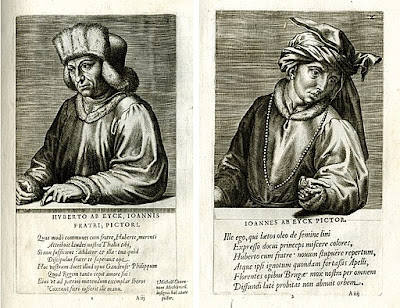 |
| Tempera - Eggs and Langridge oil paint |
Being no Art historian but wanting to branch out into oils, I like to become familiar in all aspects that teachers wish to teach so as not to doubt their knowledge and know this may come handy in some way down the track.
While I thought maybe this was the case, apparently, Tempera was in wide spread use forever before oils.
Oils were not brought into general use until the 15th century by Hubert and Jan van Eyck
 |
| https://commons.wikimedia.org/wiki/File:Hubert_und_Jan_van_Eyck.jpg |
Jan was a master artist and whilst there are oil paintings dated to the 5th century from India and China, Jan is known and the master whom perfected the technique.
According to Nicolas Pioch Oils were in use to glaze tempera and use on sculptures; The van Eycks' experimentation developed a stable varnish that that would dry at a consistent rate and aceived a new translucence and brilliance of color and light.
The original text from which I gathered the above paragraph is beautiful and can be found here, Eyck, Jan van
I'd prefer to do the right thing by the Author and link you to their site rather than copy/paste.
Now back to my big heavy book, it says that after this discovery is when oil paints went "main stream". <- not in exact copy format of course ;)
It was Venice where they really had a following due to the high humidity, oils were much less sustainable to it than the tempera had been.
So, this is where this knowledge of why the change in popularity in the mediums comes into play.
Aesthetics and properties.
Listed above is the aesthetic appeal, as for the properties, after looking at several websites just now, I assume it is the water content that made it susceptible to humidity.
I read that acrylics remain open to water (unsealed) even after drying, which if condensation is allowed access it will "fog and be vulnerable to mould" whereas oils, once cured are pretty resilient.
And according to Britannica , "True tempera is made by mixture with the yolk of fresh eggs, although manuscript illuminators often used egg white and some easel painters added the whole egg."
and if we look at the water content
Egg white = around 90% and Egg yolk = 50.1%
you can see, or imagine where the high humidity would have come into play and how exciting it would be to see "the new oils" arrive as a medium.
That's it for today's post as I have spent a few hours checking different sites as well as sharing the information I am reading in my current book.
I do enjoy how a seemingly trivial piece of knowledge about history can gift more information about something than immediately observed.
**Please note
I am NOT an expert, as I have said numerous times throughout the post, please ALWAYS seek and do your own research.
I simply share what I found interesting in case someone else may also.
Thank you for stopping by
please feel welcome to add anything further in the comments below for anyone that may come across this blog post too. Learning is listening.
*************
Comments
Post a Comment